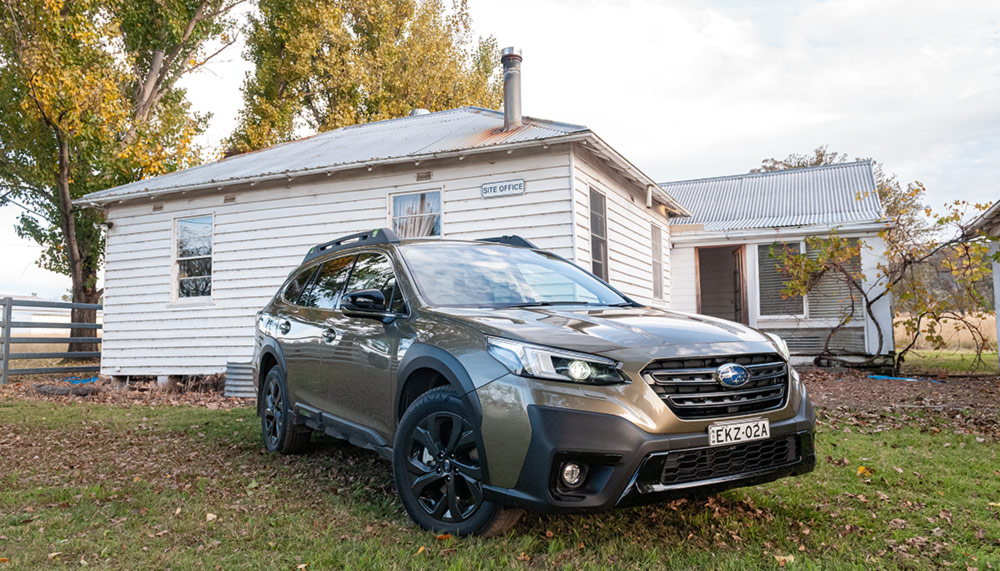The current Subaru Outback represents the smooth evolution of a proven platform.
Story + Photo Mark Muller
The sixth generation of Subaru’s much-loved Outback wagon is an effective evolution of a tried-and-true formula. The combination of a boxer engine’s low centre of gravity, constant symmetrical all-wheel-drive and raised ride height on a well-built wagon body continues to cater to Subaru devotees and attract new customers who don’t necessarily want a full-on 4WD or a tall SUV. Driving dynamics, integration of technology such as the eyeSight driver assist system, and something as solid and simple as providing a full-sized spare, combined with a good dealer network and even better after-sales service, ensure that the Subaru Outback remains favoured in regional Australia.
The line-up starts with the Outback AWD, which costs $41,490 before on-roads. The Outback Sport, tested by OUTBACK on a run up Thunderbolts Way and into New England, comes in at $45,990. This model has fixed roof rails, rather than the lighter-duty integrated pivoting roof racks of the other two models. This allows heavier loads to be carried on dedicated crossbars – think boats, bikes and combinations of the above. The interior is finished in wipe-clean materials and still runs to luxuries like heated seats. At the top end, the Outback Touring AWD will set you back $49,790. This takes the place of the previous generation’s 3.6R, and comes with soft, heated leather seats (with electronic memory for the driver), sunroof, high-end stereo and more refined accents on the bodywork, among other things.
Sadly, the silky, powerful 3.6L six-cylinder engine available for a premium in the fifth-gen Outback is no longer offered, nor is the turbo-diesel. Instead, the three models that make up the current suite are all powered by the same 2.5L naturally aspirated four-cylinder engine, delivering 136kW of power and 245Nm of torque. It’s an entirely capable powerplant, but, frankly, it left us wanting more. It could well be a case of motor memory, because having spent years in the 3.6R, OUTBACK missed having the easily tapped power to surge uphill while overtaking and then still have more oomph if needed. The 2.5L engine will lift, but it feels like it needs to be pushed to get close to its power potential. It redlines at 6000–8000 revs, and there’s no need to flog it that far to get maximum torque, but it’s just … different. Subaru claims an average fuel-usage figure of 7.3L/100km. OUTBACK rang 7.9L/100km out of the 63L fuel tank across 1040km of fairly mixed driving, which is not bad.
If you’re used to the 2.5L engine available in the lower grades of the fifth generation Outback, or your driving is generally reserved and conducted on flatter country, then it’s probably not an issue. Still, Subaru has evidently been listening, and for those who do want more power, it’s worth waiting for a bit – the turbo-charged 2.4L four-cylinder engine that’s been on offer in the USA since the sixth-generation Outback went on-sale in 2020 will be available in Australia in 2023. It reportedly delivers 202kW of power at 5,600rpm, and 350Nm of torque from 2,000 to 5,200rpm – more power than the 3.6R’s 191kW.
All of that aside, the Outback Sport as tested does an excellent job of navigating the winding, steep, broken-up back roads of Thunderbolts Way. Mashed-up bitumen, gravel, variable camber and potholes are a feature of this picturesque route, and the Subaru takes it all in its stride. The suspension tuning is ideal for this kind of driving, and the responsiveness, road feel, steering and comfort levels are all high. And, with plenty of room for four adults, and a load-space of 522L (which bellows out to 1267L with the rear seats folded down), it’s a great touring vehicle.
The eyeSight system works brilliantly, with stereoscopic cameras and a well-calibrated electronic brain keeping the excellent adaptive cruise control, lane keeping, steering assist and collision avoidance functions well engaged. Some might feel these systems are intrusive, but for OUTBACK’s money, the added layers of safety increase security and confidence. You’re still driving the car, but you know that the car is busy watching things in a way that if it spots a kangaroo a split-second faster than the human eye, good. The occasional false alert is easily overridden and doesn’t really detract from the driving experience.
Service intervals are now extended to a more user-friendly 12-month or 12,500km. Service costs for the first five visits – over five years or 60,000km – total $2,450. Subaru has an excellent reputation for looking after its customers long after the salespeople have exited the equation, and that counts for a lot.
Overall build quality, fit and finish are high, and the continued adaptation and integration of new technologies combined with a fairly reserved and minimalist design aesthetic all contribute to the Subaru Outback’s ongoing appeal for people looking for value, style, comfort, practicality and reliability.
This story excerpt is from Issue #144
Outback Magazine: August/September 2022










